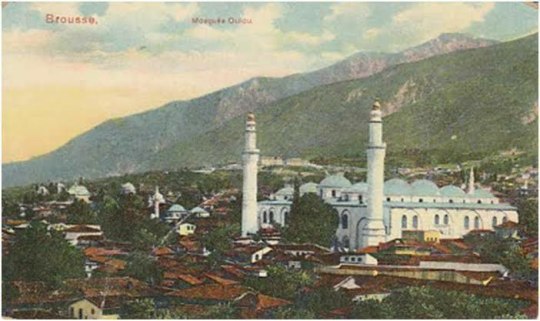#Evliya Çelebi
Explore tagged Tumblr posts
Text


haven’t been able to stop thinking about this since seeing it on twitter, so: please enjoy the story of the incredibly cursed honey
17 notes
·
View notes
Text

Evliya Çelebi seyahatnamesinde, XVII. asırda Ulucami'de yetmiş ayrı ilim halkası kurulduğunu ve bu halkalarda iki bin kişiye ders verildiğinden bahsetmektedir. Bu derslerde dini ilimlerin yanında tıp, tarih gibi başka ilimlerde vardı.
Bursa Ulu Cami
32 notes
·
View notes
Text

Evliya Çelebi
17 th Century Otoman Traveller
2 notes
·
View notes
Text

Evliya Çelebi - Seyahatname

#kitap#edebiyat#kitapkurdu#kitaplar#book#kitap alıntıları#kitap alıntısı#mimar sinan#selimiye#mimari#evliya çelebi
5 notes
·
View notes
Text


Çelebi, Kaytak kabilesini anlatıyor, 17. yüzyıl; "Bu diyarda Kaytak kavmi derler, yirmi bin kadar nüfusu olan kavimdir ki Dağıstan hududundadır. Bazı zaman Aras şehrine ve bazı zaman Şeki şehrine gelip pazarlık ederler. Bir acayip görünüşlü, Dabbetü'l-arz (kıyamette çıkacak hayvan) gibi kazan başlı, torba taçlı, iki parmak enli kaşlı ve omuzlarında birer adam oturacak kadar geniş omuzlu, göğsü geniş, beli ince, uylukları şişman, tabanları yassı, gözleri yuvarlak ve kırmızı suratlı kişilerdir. Ne zaman Araş ve Şeki Kalesi pazarlarına gelseler hepsi yaya olarak ovaya inip Şeki arabalarına binerler. Zira çok şişman ve iri adamlar olduklarından onları at ve katır götürmeye tahammül edemez. Arabalara ve iri camuzlara eyer vurup camuzlara binerek başlarında hamam kubbesi kadar sarıklarıyla Kırım kadısı gibi bıyıkları tıraşlı uzun sakallı olup iki taraflarına muhteşemce selam vererek geçtiklerinde sanki bir sürü Deccal kavmi geçer. Bir acayip ve tuhaf görünüşlü Oğuz taifeleridir. Bütün Gilan, Şirvan ve Şamakı halkının maskaralarıdır. Gayet Oğuz kavimdir." Evliya Çelebi Seyahatnamesi / Yapı Kredi Yayınları
2 notes
·
View notes
Text
‘Çok gerekmedikçe paranı, inancını ve fikri yorumunu gizli tut.’
-Evliya Çelebi

13 notes
·
View notes
Text
Bilim İnsanları Çizgi Roman Serisinin İlk Kitapları Erişime Açıldı
Millî Eğitim Bakanlığı Temel Eğitim Genel Müdürlüğü tarafından başlatılan çalışma kapsamında bilim, kültür ve sanat tarihine yön veren millî şahsiyetlerin öneminin nostaljik formdaki çizimlerle zenginleştirilerek Türkçe ve İngilizce olarak aktarıldığı çizgi romanlar, erişime açıldı. Bilim Tarihimizin Çizgi Roman Karakterleri: Harizmi, Cezeri, Piri Reis ve Evliya Çelebi Sıfırı ilk kez kullanan…
#Cezeri#Evliya Çelebi#Harizmi#Marmara#Milli Eğitim Bakanlığı#Piri Reis#Sakarya#Sakarya İl Milli Eğitim Müdürlüğü
0 notes
Text
Bilim İnsanları Çizgi Roman Serisinin İlk Kitapları Erişime Açıldı
Millî Eğitim Bakanlığı Temel Eğitim Genel Müdürlüğü tarafından başlatılan çalışma kapsamında bilim, kültür ve sanat tarihine yön veren millî şahsiyetlerin öneminin nostaljik formdaki çizimlerle zenginleştirilerek Türkçe ve İngilizce olarak aktarıldığı çizgi romanlar, erişime açıldı. Bilim Tarihimizin Çizgi Roman Karakterleri: Harizmi, Cezeri, Piri Reis ve Evliya Çelebi Sıfırı ilk kez kullanan…
#Cezeri#Evliya Çelebi#Harizmi#Marmara#Millî Eğitim Bakanlığı#Piri Reis#Sakarya#Sakarya İl Milli Eğitim Müdürlüğü
0 notes
Link
#masumiyet müzesi#mevlana#fuzuli#evliya çelebi#namık kemal#ahmet mithat efendi#tevfik fikret#halide edip adıvar#nazım hikmet#orhan pamuk#türk edebiyatı#ünlü#divan edebiyatı#tazminat dönemi#cumhuriyet dönemi#modern türk şiiri#edebi eserler#halk edebiyatı#mesnevi#leyla ile mecnun#seyahatname#yunus emre
0 notes
Text
#enfeskanal 💖
Evliyâ Çelebi ve Rüyâsı.. Beğenilerle, yorumlarla kanalıma destek olun. Kalıcı tâkip lütfen 🙏💖 https://youtu.be/7mnA389cbms?feature=shared
youtube
#keşfet#trend#subscribe#takip edilesi bloglar#Evliya çelebi#travel#seyahat#gezi#rüya#dream#secret#gizem#bilgi ambarı#tâkip ambarı👑#Youtube kanalıma abone ol#Her telden#Enfes kanal#Youtube
0 notes
Text
“Altınova’yı dünya tanıyacak”
Altınova Belediye Başkanı Dr. Metin Oral, 15-22 Nisan tarihleri arasındaki Turizm Haftasını kutladı. Başkan Oral, her alanda olduğu gibi turizm alanında da ilçenin gelişerek, bölgenin gözde yerleri arasına girdiğini dile getirdi. Başkan Oral, ilçede tarihi, sanayiyi, tarımı ve kültürü bir arada yürüttüklerini, bu değerlere turizmi de eklemek için ciddi çalışmalar yaptıklarını söyledi. Başkan…

View On WordPress
#Altınova#Antik Liman#Arkeoloji#Çobankale#Belediye Başkanı#Bizans#Bizans İmparatorluğu#Deniz Feneri Müzesi#Doğa Eğitim Merkezi#Evliya Çelebi#Hersek Lagünü#Hersekzade Ahmet Paşa Külliyesi#Kuş Oteli#Limnae Antik Kenti#Metin Oral#Osmangazi Köprüsü#Osmanlı İmparatorluğu#Turist#Turizm Haftası#Tıbbi ve Aromatik Bitkiler Bahçesi#Yalova
0 notes
Text
dümdüz otururken yazılım öğrenme və ankaraya gitmə ihtiyacı hasıl oluyor
9 notes
·
View notes
Text
Evliya Çelebi Mahallesi Tesisatçı & Su Tesisatçısı
Evliya Çelebi Mahallesi Tesisatçı Su Tesisatçısı Evliya Çelebi Mahallesi Tesisatçı Su Tesisatçısı Evliya Çelebi Mahallesi Tesisatçı & Su Tesisatçısı 0545 641 1018 #Evliya Çelebi Mahallesi Tesisatçı #Evliya Çelebi Mahallesi Su Tesisatçısı #Evliya Çelebi Mahallesi Tesisatçı #Evliya Çelebi Mahallesi Su Tesisatçısı #Evliya Çelebi Mahallesi Sıhhi Tesisatçı #Evliya Çelebi Mahallesi Tesisat Servis…

View On WordPress
0 notes
Text
Afyonkarahisar'da Mutlaka Yapılması Gereken En İyi Aktiviteler!
Afyonkarahisar, tarihi zenginlikleri, doğal güzellikleri ve eşsiz lezzetleriyle bezeli bir şehir olarak dikkat çekiyor. Şehre seyahat edenler, tarihin derinliklerinden günümüze uzanan bir serüvene çıkıyorlar. Afyonkarahisar’ın bu benzersiz atmosferini keşfetmek isteyenler için, şehirde mutlaka deneyimlenmesi gereken birçok aktivite bulunmaktadır. İşte “Afyonkarahisar’da Mutlaka Yapılması Gereken…

View On WordPress
#Afyon Ulu Camii#Afyon&039;da neler yapılır#Afyonkarahisar aktiviteleri#Afyonkarahisar gezilecek yerler#Afyonkarahisar Hayvanat Bahçesi#Afyonkarahisar kale#Afyonkarahisar mutfağı#Afyonkarahisar&039;da yapılacak aktiviteler#Evliya Çelebi Müzesi#Frig Vadisi#gurme lezzetler#Kocatepe Spor Kompleksi#Şehitler Abidesi#Sultan Marshes Kuş Cenneti#termal sular
0 notes
Text
Ölüm olduktan sonra sızlanmak ne boyna borç ola? Ben bir can için minnet mi ederim !?
Evliya Çelebi - Seyahatname

#kitap#edebiyat#kitapkurdu#kitaplar#book#kitap alıntıları#kitap alıntısı#kitaptan alıntı#kitaptansözler#seyahatname#evliya çelebi
5 notes
·
View notes
Text
Bir rivayet odur ki kim Resulullah'ı rüyasında görse ve ondan bir şey dilese dünyada,ahirette ona sahip olur. Bu yüzden de Evliya Çelebi için Resulullah'ı rüyasında görmüş. Şefaat ya Resulallah diyemeyip seyahat ya Resulullah dediği için seyahatname çıkaracak kadar yer gezmiş denilir. Bu yüzden de hep küçüklüğümden beri Resulullah'ı rüyada görüp bir şey demeyi hayal ederdim.
42 notes
·
View notes